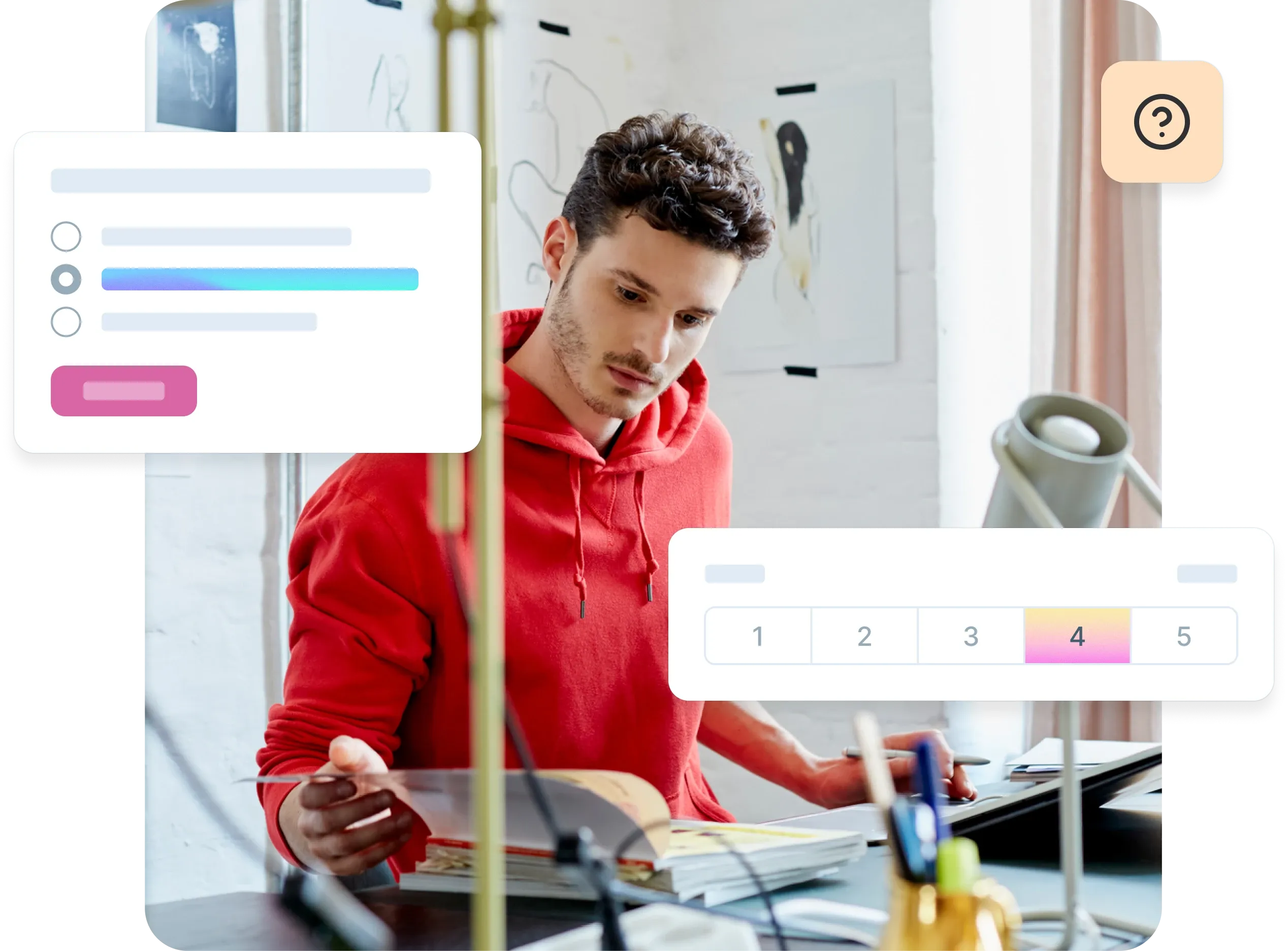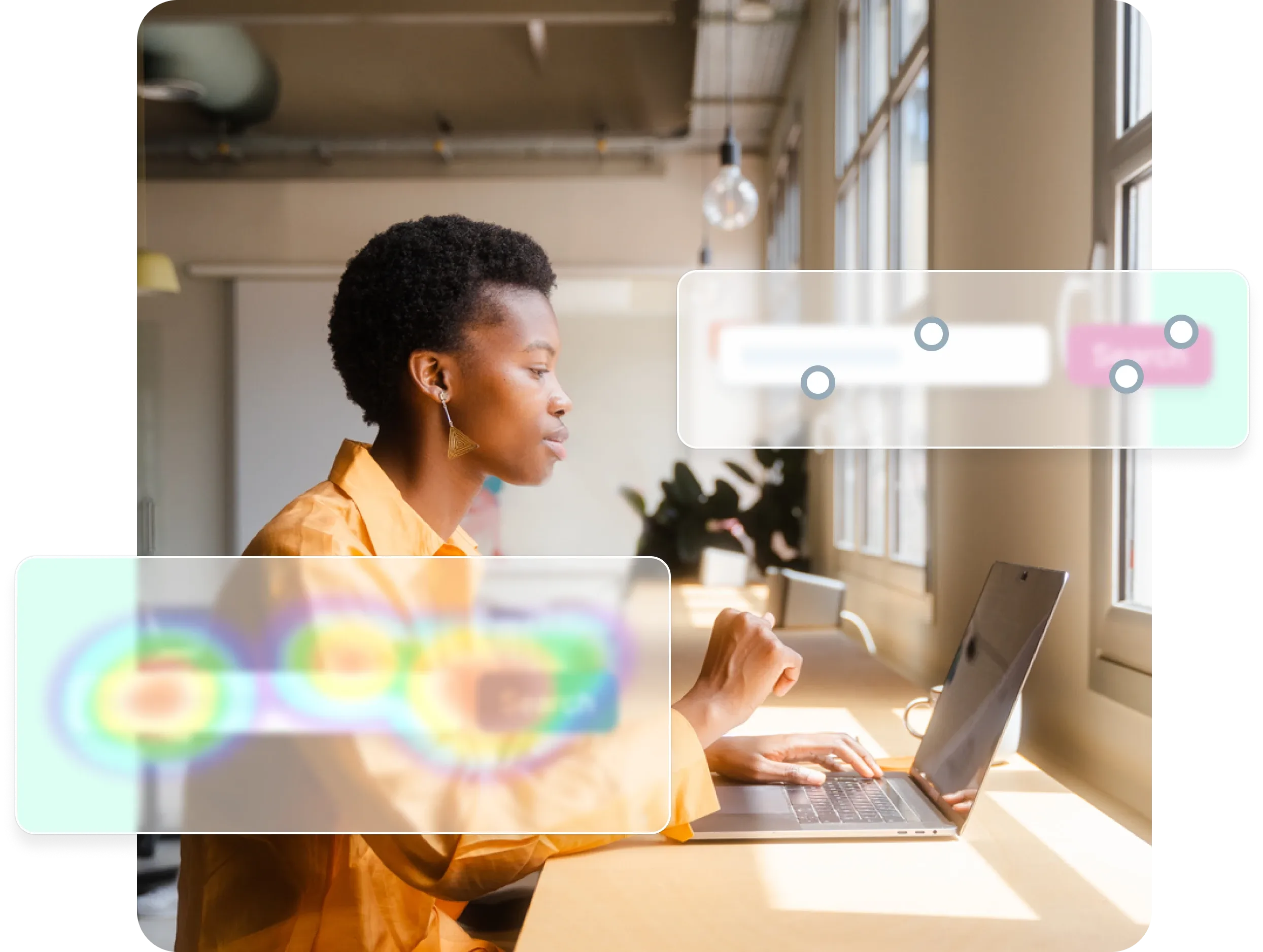Usability test plan
Create a usability test plan to ensure everything runs smoothly. Learn how to set research objectives, recruit participants, choose usability testing methods, create tasks, and establish evaluation criteria.
Usability testing guide
Creating a successful usability study starts with one critical foundation: a comprehensive usability test plan. Without this roadmap, even the most well-intentioned research can lead to unclear findings, wasted resources, and missed opportunities to improve your product's user experience.
A usability test plan serves as your blueprint for conducting effective user research, ensuring every session delivers actionable insights that drive meaningful product improvements.
Whether you're testing a new feature, validating a design concept, or investigating user pain points, a well-structured plan transforms scattered observations into strategic direction.
The difference between successful usability testing and disappointing results often comes down to preparation. Teams that invest time in thorough planning consistently gather more valuable insights, make better design decisions, and build products that truly serve their users' needs.
What is a usability test plan?
A usability test plan is a comprehensive document that outlines the objectives, participants, tasks, environment, and success criteria for conducting usability testing.
Think of it as your research blueprint – a detailed guide that ensures every aspect of your testing process is purposeful, consistent, and aligned with your broader product goals.
A usability test plan serves multiple critical functions:
Sets clear expectations for all stakeholders
Provides a structured framework for moderators to follow
Establishes measurable criteria for evaluating success
Helps prevent bias and ensures that your testing methodology remains consistent across multiple sessions and team members
A well-crafted usability test plan typically includes the following key elements:
Research objectives and hypotheses
Participant recruitment criteria and sample size
Detailed task scenarios and success metrics
Testing methodology and environment specifications
Roles and responsibilities for team members
Timeline with logistical considerations
Its purpose extends beyond just organizing your research. A solid plan aligns stakeholders around common goals, helps secure buy-in and resources for testing, reduces the risk of bias influencing results, and creates a reusable framework for future studies.
When everyone understands what you're testing, why you're testing it, and how success will be measured, your research becomes more focused and impactful.
Get usability insights that matter
From first click tests to preference surveys, Lyssna helps you understand exactly how users interact with your designs.
Why you need a usability test plan
The value of a usability test plan becomes clear when you consider what happens without one. Teams that skip planning often find themselves with inconsistent testing approaches, unclear or contradictory findings, difficulty comparing results across sessions, and stakeholders who question the validity of insights.
Provides structure and repeatability
A usability test plan creates a systematic approach that can be replicated across different studies, team members, and time periods. This consistency is crucial for building reliable insights and establishing benchmarks for measuring improvement over time. When you follow a structured plan, you can confidently compare results from different testing rounds and track progress toward your usability goals.
Keeps tests aligned with research goals
Without a clear plan, it's easy for testing sessions to drift away from your core research questions. A well-defined plan keeps everyone focused on the specific insights you need to gather, ensuring that every minute of testing time contributes to answering your most important questions about user behavior and product performance.
Ensures unbiased, valid results
Bias can creep into usability testing in numerous ways – from leading questions to inconsistent task presentation. A comprehensive plan helps standardize your approach, reducing the risk of inadvertently influencing participant behavior or drawing conclusions that aren't supported by the data. This standardization is essential for generating insights that stakeholders can trust and act upon.

Key components of a usability test plan
An effective usability test plan brings together multiple elements that work in harmony to create a comprehensive research framework. Each component serves a specific purpose in ensuring your testing delivers valuable, actionable insights.
Component | What to include |
|---|---|
Objectives and goals | Specific, measurable questions you want answered (e.g. "Can users complete checkout without help?"). Include primary and secondary objectives. |
Target audience | Who will participate based on demographics, experience level, and behaviors. Define inclusion and exclusion criteria. |
Methodology | Choose between moderated vs. unmoderated, remote vs. in-person, and qualitative vs. quantitative approaches based on your goals. |
Test environment | Testing platforms (Lyssna, Zoom), recording tools, device requirements, and any accessibility considerations. |
Task scenarios | Realistic stories that give users reasons to complete tasks (e.g., "You need to contact support about a recent order"). |
Metrics and success criteria | Quantitative data (completion rates, time on task, errors) and qualitative insights (satisfaction, feedback, pain points). |
Team roles | Who does what: moderator (guides sessions), observers (take notes), technical support (manages recording), analysis lead (synthesizes findings). |
Schedule and logistics | Timeline, session length, participant incentives, time zones, and backup plans for technical issues or no-shows. |
Objectives and goals
Your objectives and goals form the foundation of your entire testing strategy. These should clearly articulate what you want to learn from the research and how the insights will inform product decisions.
Pro tip: Effective objectives are specific and measurable. Instead of vague goals like "improve the user experience," focus on precise questions such as "Can users complete the checkout process without assistance?" or "Do users understand the purpose of our new onboarding flow?"
These specific objectives help you design appropriate tasks and establish relevant success criteria.
Consider both primary and secondary objectives too. Primary objectives address your most critical research questions, while secondary objectives explore additional areas of interest that might emerge during testing. This hierarchy helps you prioritize your time and ensures you gather essential insights even if sessions run shorter than expected.
Target audience and participants
Defining your target audience ensures you're testing with people who represent your actual users. This involves creating detailed participant criteria that reflect your user base's demographics, behaviors, and needs.
Start by identifying key user personas or segments that interact with the feature or product you're testing. Consider factors like experience level with similar products, frequency of use, device preferences, and any specific domain knowledge that might influence their interaction with your product.
Pro tip: Establish both inclusion and exclusion criteria. Inclusion criteria define who should participate (age ranges, job roles, technical proficiency levels), while exclusion criteria identify who shouldn't participate (internal employees, expert users for general usability tests, or people with conflicts of interest).
Methodology
Your methodology section outlines the specific approach you'll take to conduct the research. This includes decisions about moderated versus unmoderated testing, remote versus in-person sessions, and qualitative versus quantitative data collection.
Moderated vs unmoderated testing: Moderated sessions allow for real-time follow-up questions and deeper exploration of user behavior, while unmoderated testing can reach more participants and capture more natural behavior without moderator influence.
Remote vs in-person testing: Remote testing offers broader participant reach and more natural environments, while in-person testing provides richer observational data and better control over the testing environment.
Consider your research goals, timeline, and resources when making these methodological choices. Each approach has distinct advantages that align with different research objectives.
Check out our video below for everything you need to know about unmoderated usability testing.
Test environment and tools
Specify the technical setup and usability testing tools you'll use to conduct and record your testing sessions. This includes decisions about testing platforms, screen recording software, analytics tools, and any specialized equipment needed.
Pro tip:
For remote testing, you might use platforms like Lyssna for unmoderated and moderated studies.
For in-person testing, consider factors like room setup, device configuration, and recording equipment. Document any specific browser requirements, device types, or accessibility considerations that might affect the testing environment.
Task scenarios
Task scenarios provide the context and motivation for user actions during testing. These should feel realistic and relevant to participants while allowing you to observe the specific behaviors you want to study.
Effective scenarios tell a brief story that gives users a reason to complete the task. For example, instead of saying "Find the contact page," you might say "You have a question about your recent order and need to get in touch with customer support." This approach creates more natural user behavior and provides better insights into how people actually use your product.
Important note:The Nielsen Norman Group's 5-user guideline applies specifically to qualitative usability testing, where the goal is to identify usability issues – with 5 participants uncovering approximately 85% of problems. This guideline doesn't apply to quantitative studies that aim to measure metrics like success rates or task times.
For quantitative studies that need statistical significance and narrow confidence intervals, Nielsen Norman Group recommends 40 or more participants to ensure the results generalize reliably to your broader user population.
Metrics and success criteria
Establish clear, measurable criteria for evaluating usability test performance. This includes both quantitative metrics (task completion rates, time on task, error frequencies) and qualitative indicators (user satisfaction, frustration points, verbal feedback).
Quantitative metrics provide objective measures of usability performance. Common metrics include task success rate, time to complete tasks, number of errors, and navigation efficiency. If 10 users attempt a task and 8 of them complete it successfully, then the completion rate for that task is 80%.
Qualitative metrics capture the user experience beyond pure performance data. These might include satisfaction ratings, emotional responses, preference feedback, and suggestions for improvement. Both types of metrics are essential for a complete understanding of usability performance.
Roles and responsibilities
Clearly define who will be responsible for each aspect of the testing process. This typically includes roles like:
Moderator (guides sessions and asks questions)
Observers (take notes and identify patterns)
Technical support (manages recording and troubleshooting)
Analysis lead (synthesizes findings and creates reports)
Establishing these roles in advance prevents confusion during testing sessions and ensures that all important aspects of data collection are covered. It also helps team members prepare appropriately for their specific responsibilities.
Schedule and logistics
Document the practical details of conducting your testing sessions, including timeline, session length, participant incentives, and any special requirements. This section should address scheduling considerations, backup plans for technical issues, and coordination between team members.
Pro tip: Consider factors like participant availability, time zones for remote testing, and any seasonal or business cycle considerations that might affect your research. Plan for contingencies like participant no-shows or technical difficulties that could disrupt your schedule.

Example usability test plan template
Here's a practical template you can adapt for your own usability testing needs.
Use this template to plan and organize your usability testing study. A well-structured test plan helps align your team, communicate your approach to stakeholders, and allow you gather the feedback you need to improve your product. Placeholder text has been used here – simply customize each section based on your specific research goals and context. Project overview Project: [Product/Feature Name] Usability Study Testing period: [Start date] – [End date] Research team: [Names and roles] Stakeholders: [Names and departments] Research objectives What do you want to learn from this study? Clear objectives help you stay focused and help your research addresses the right questions. Primary objective: Evaluate task completion rates for the new checkout flow Secondary objectives:
Research questions:
Participants Who you recruit directly impacts the quality of the feedback you’ll gather. Define your target audience clearly to make sure you’re testing with the right people. Target number: 8–10 participants Who we’re recruiting: Online shoppers aged 25–45 who make purchases 2+ times per month Why this audience: This represents our core user base who regularly engage with ecommerce checkout flows and can provide informed feedback based on their shopping habits. Who we’re excluding:
Recruitment method: Recruited from the Lyssna research panel Screener questions:
Methodology Study type: Unmoderated remote prototype testing Session duration: 15–20 minutes per participant Platform: Lyssna Testing environment: Participants use their own devices and internet connection Materials needed:
Tasks and scenarios Write realistic, scenario-based tasks that reflect how people would naturally use your product. Good scenarios provide context and motivation without revealing the solution. Task 1: Find and purchase a product **Scenario: “**You're looking for a birthday gift for a friend with a budget of $50. Find and purchase something appropriate.” What we’re testing: Overall navigation, product discovery, and checkout completion Success criteria: Participant completes purchase without assistance Task 2: Update shipping information **Scenario: “**You realize you entered the wrong shipping address. Update your delivery information.” What we’re testing: Account management and order modification Success criteria: Participant locates and updates shipping address within 2 minutes Task 3: Check order status **Scenario: “**Check the status of your order and estimated delivery date.” What we're testing: Post-purchase experience and information findability Success criteria: Participant finds order status information without prompting Success metrics How will you measure whether your design is meeting user needs? Define both quantitative and qualitative success criteria. Quantitative metrics:
Qualitative metrics:
Team roles Test creator: [Name] Sets up the test in Lyssna, writes task scenarios, configures success criteria Analysis lead: [Name] Reviews recordings, synthesizes findings, identifies patterns and insights Stakeholder liaison: [Name] Communicates with stakeholders, shares progress updates, presents findings Schedule Building in time for each phase helps keep your research on track and ensures you have adequate time for analysis and reporting. Test setup and pilot: [Date] Build your test in Lyssna, run through it yourself, and pilot to make sure everything works Participant recruitment: [Date range] Launch recruitment through the Lyssna research panel or your own participant list Data collection: [Date range] Participants complete the test asynchronously Analysis and synthesis: [Date range] Review recordings, synthesize findings, identify patterns and insights Report delivery: [Date] Share findings with stakeholders Analysis and reporting plan Analysis approach:
Deliverables:
Budget and resources Participant incentives: [Amount per participant] Total incentive budget: [Total amount] Tools and software: Lyssna (including research panel access) Additional resources: [Any other costs or resources needed] Risks and mitigation What could go wrong, and how will you handle it? Potential risk: Low recruitment or high dropout rates Mitigation: Over-recruit by 20%, ensure screening questions are clear and incentive is appropriate Potential risk: Technical issues with prototype or test link Mitigation: Test all links and prototypes before launching, have backup version ready Potential risk: Participants misunderstand tasks Mitigation: Write clear, specific task instructions, pilot test with 1–2 participants first Approvals Reviewed by: [Name, Date] Approved by: [Name, Date] |
Use this free template to organize your usability study from start to finish. Simply duplicate it and customize each section based on your research goals.
We've created a free usability test plan template to help you get started. It includes all the sections covered above – from research objectives and participant recruitment to task scenarios and analysis plans. Duplicate the template and adapt it for your specific project needs.

Define usability testing goals and objectives
Clear goals and objectives ensure usability testing delivers actionable insights and measurable results that directly inform product decisions. Without well-defined goals, testing sessions can become unfocused explorations that generate interesting observations but fail to answer the specific questions your team needs to address.
The process of defining goals also helps align stakeholders around common priorities and creates shared understanding of what constitutes successful research outcomes. When everyone agrees on what you're trying to learn, it becomes much easier to design effective testing protocols and interpret results in ways that drive meaningful product improvements.
Why defining goals matters
Clear objectives transform usability testing from a generic exercise into a strategic tool for product improvement. Here’s why it matters:
Prevents wasted sessions: Clear goals transform vague observations ("users seemed confused") into actionable findings that directly answer your product questions and guide design decisions.
Aligns with business priorities: Well-defined goals connect user research to business objectives and KPIs, making it easier to justify research investments and demonstrate measurable outcomes.
Builds stakeholder support: When stakeholders understand what testing aims to achieve and its expected impact, they're more likely to provide resources and champion ongoing research initiatives.
What are usability testing goals?
Usability testing goals are high-level outcomes that guide your research strategy and determine which methods and metrics will be most valuable for your study.
Example goals include:
Evaluate task completion capability
Assess interface intuitiveness
Validate accessibility and inclusivity
Identify optimization opportunities
Goal type | Focus and purpose |
|---|---|
Evaluate task completion | Test whether users can successfully complete key tasks (registration, purchase, content creation) to identify major barriers to success. |
Assess interface intuitiveness | Evaluate how easily first-time users navigate without training, testing clarity of information architecture and interaction design. |
Validate accessibility | Ensure the product works for users with different abilities, devices, and technical skills to create inclusive experiences. |
Identify improvements | Discover optimization opportunities even when functionality works adequately, supporting continuous improvement efforts. |
What are usability testing objectives?
Usability testing objectives are specific, measurable criteria that support your broader goals. While goals provide general direction, objectives establish concrete benchmarks that allow you to evaluate success and track progress over time.
Example objectives include:
Performance-based objectives
Error-based objectives
Satisfaction-based objectives
Learning-based objectives
Type | Example objectives | Focus |
|---|---|---|
Performance | • 80% complete checkout in under 3 minutes • Users find contact info within 2 clicks | User performance and success criteria |
Error rates | • Error rate below 10% for sign-up • Less than 20% need help with primary task | Areas where users struggle |
Satisfaction | • Average rating 4+ out of 5 • Net Promoter Score above 7 | Emotional and subjective experience |
Learning | • Understand value prop in 30 seconds • 90% can explain feature purpose after use | Comprehension and mental models |

How to define usability testing goals and objectives
Creating effective goals and objectives requires connecting user research to business priorities and product strategy. This process ensures that your testing efforts generate insights that directly support decision-making and product improvement.
Step 1 – Identify key business and UX priorities
Understand the broader context by connecting testing to business metrics and user challenges.
Key actions | What to consider |
|---|---|
1. Align with KPIs | Conversion rates, retention, task success, satisfaction scores |
2. Balance priorities | Immediate fixes (known issues) vs. strategic exploration (new features) |
Pro tip: Consider both immediate priorities (fixing known usability issues) and strategic priorities (exploring new feature concepts or validating design directions). This balance helps you address urgent needs while also building knowledge for future product development.
Step 2 – Translate priorities into usability goals
Transform business priorities into specific research goals that testing can address. This translation process requires thinking about how user behavior and experience directly relate to the outcomes you want to achieve.
Business priority | Example usability goal |
|---|---|
1. Increase conversions | Evaluate checkout process effectiveness |
2. Improve mobile experience | Assess mobile navigation and identify optimization opportunities |
Pro tip: Make sure your goals are achievable through usability testing methods. Some questions are better answered through other research approaches like surveys, analytics analysis, or user interviews.
Step 3 – Define success criteria
Establish specific, measurable criteria that will indicate whether you've achieved your testing goals.
Criteria type | Examples and considerations |
|---|---|
1. Quantitative metrics | Time on task, error rates, completion rates |
2. Qualitative indicators | Satisfaction scores, user feedback themes |
3. Standardized measures | System Usability Scale (SUS), Net Promoter Score (NPS) |
Pro tip: Set realistic benchmarks based on your current performance, industry standards, or competitor analysis. Overly ambitious criteria can make successful outcomes feel disappointing, while criteria that are too easy don't provide meaningful direction for improvement.
Step 4 – Keep objectives realistic and actionable
Avoid testing too many goals at once, as this can dilute your focus and make it difficult to gather deep insights about any single area.
Best practice | Implementation |
|---|---|
Limit scope | Focus on 3-5 objectives per study for thorough exploration. |
Consider constraints | Account for session length, participant fatigue, task complexity. |
Drive decisions | Design objectives that inform specific product actions. |

Examples of usability testing goals and objectives
Understanding how goals and objectives work together becomes clearer through concrete examples that show how broad research intentions translate into specific, measurable criteria.
Goal: Improve checkout usability
Objective: 90% of users complete checkout without errors
Objective: Average checkout time under 2 minutes
Objective: Fewer than 1 support request per 100 transactions
Goal: Enhance mobile navigation
Objective: Users find FAQ section in under 10 seconds
Objective: 85% of participants successfully navigate to product categories
Objective: Mobile task completion rate matches desktop performance
Goal: Reduce onboarding drop-off
Objective: 70% of users complete signup without external help
Objective: Users understand core value proposition within first 30 seconds
Objective: Onboarding completion rate increases by 25%
Goal: Validate new feature concept
Objective: 80% of participants understand the feature's purpose
Objective: Users express interest in using the feature (4+ out of 5 rating)
Objective: Feature concept aligns with user mental models
These examples demonstrate how specific, measurable objectives support broader research goals while providing clear criteria for evaluating success.
Common mistakes in setting test goals
Even experienced researchers can fall into common traps when defining usability testing goals. Being aware of the following pitfalls helps you create more effective research plans that generate actionable insights.
Mistake | Problem | Better approach |
|---|---|---|
Vague goals | Goals like "make it easier" lack specificity for testing protocols or measuring success | Focus on specific aspects: "Reduce steps in account setup" or "Improve payment error recovery" |
Mixing business outcomes with test tasks | "Increase conversion rates" is a business outcome, not measurable in usability testing | Focus on user behaviors that contribute to outcomes: task completion, error rates, time on task |
Ignoring measurable KPIs | Without metrics, you can't determine success or track improvement over time | Include specific metrics to evaluate performance and communicate results clearly |
Define participant criteria
Selecting the right participants is crucial for generating insights that accurately reflect your actual user base. The people you test with should represent the diversity and characteristics of your real users, ensuring that your findings are relevant and actionable.
Target personas
Match participants to real customer segments. Use established personas or consider these key characteristics:
Goals and motivations
Experience levels
Usage contexts
Domain knowledge
Pro tip: If you're serving diverse groups, test with multiple persona types to identify segment-specific issues.
Demographics and behavior
Define criteria that reflect your user base, such as:
Age and location
Technical proficiency
Job role or industry
Device usage patterns
Product usage frequency
Pro tip:
Document: Required (must-have) and preferred (nice-to-have) criteria
Avoid: Overly restrictive requirements that make recruitment difficult
Exclusion criteria
Clearly specify who shouldn't participate in your testing to avoid bias and ensure representative results.
Common exclusions:
Internal employees or contractors
UX professionals or designers
Expert users (unless testing advanced features)
People with conflicts of interest
Important: Fresh perspectives can reveal issues that experienced users tend to work around. Avoid exclusions that reduce diversity – protect validity without creating barriers to inclusive representation.

How many participants do you need?
The optimal number depends on your research goals and methodology.
Qualitative testing: 5 users
For identifying usability issues and understanding behavior patterns. Five participants uncover approximately 85% of problems (Nielsen Norman Group).
Quantitative testing: 40+ users
For measuring metrics like success rates, task times, and error frequencies with statistical significance. Nielsen Norman Group recommends 40+ participants for reliable results.
Iterative testing approach
Rather than one large study, run multiple rounds with 5-7 users, make improvements, and test again. This iterative approach validates improvements and discovers new issues that emerge after initial fixes – often providing better insights more cost-effectively than a single large study.
Quick decision guide
If your goal is to... | Use this approach |
|---|---|
Identify major usability issues | 5 participants (qualitative) |
Understand user behavior patterns | 5-7 participants (qualitative) |
Compare design approaches | 40+ participants (quantitative) |
Establish baseline metrics | 40+ participants (quantitative) |
Iterate and improve quickly | 5-7 participants × multiple rounds |
Methods to recruit usability testing participants
Effective participant recruitment ensures you're testing with people who represent your actual user base. Different recruitment methods offer various advantages in terms of cost, speed, relevance, and sample quality.
Quick comparison guide
Method | Cost | Speed | Best use case |
|---|---|---|---|
In-house recruitment | Low | Moderate | Testing existing features with experienced users |
Recruitment panels & agencies | High | Fast | Large-scale studies with specific demographics |
Social media & online communities | Low-Medium | Variable | Niche audiences and B2B products |
Guerrilla recruitment | Very Low | Immediate | broad audiences |
In-house recruitment
Recruiting from your existing customer base, newsletter subscribers, or CRM database can provide highly relevant participants who are already familiar with your brand and product category.
Pros: Participants have genuine interest in your product, recruitment costs are minimal, and you can access users with specific experience levels or usage patterns.
Cons: Existing customers might have biases or learned behaviors that don't reflect new user experiences, and sample diversity might be limited to your current user base.
This approach works particularly well when testing improvements to existing features or exploring advanced functionality that requires domain knowledge.
Recruitment panels and agencies
Professional recruitment services and testing platforms often provide access to large, diverse participant pools with sophisticated screening capabilities.
If you're using a remote testing platform like Lyssna, you can use a research panel to make recruiting participants easier. Lyssna's research panel calculator allows you to enter your study size, type, and audience to get an estimate of the cost and turnaround time.
Pros: Fast recruitment, scalable to large sample sizes, access to specific demographic segments, and professional screening processes.
Cons: Higher costs per participant.
This method is ideal when you need specific demographic criteria, large sample sizes, or rapid recruitment timelines.
Social media and online communities
Recruiting through LinkedIn groups, Reddit communities, Facebook groups, or Slack channels can help you reach niche audiences and specific professional segments.
Pros: Access to highly targeted communities, often lower costs, and participants who are genuinely engaged with relevant topics.
Cons: Recruitment can be time-consuming, response rates may be unpredictable, and community guidelines might limit recruitment activities.
This approach works well for B2B products, professional tools, or niche consumer products with active online communities.
Guerrilla recruitment
Guerrilla usability testing, where you recruit participants in public spaces like coffee shops, co-working spaces, or events can provide quick access to diverse participants for certain types of testing.
Pros: Very low cost, immediate availability, and access to people who might not participate in formal research studies.
Cons: Less control over participant screening, limited session time, and potential environmental distractions.
This method is most appropriate for quick concept validation or testing products with broad appeal that don't require specialized knowledge.

Incentives for usability test participants
Appropriate research incentives show respect for participants' time and expertise while encouraging high-quality participation in your research. The right incentive structure can significantly improve recruitment success and participant engagement.
Common incentive types
Gift cards to popular retailers
Cash payments
Product discounts or credits
Free trials or premium features
Charitable donations on their behalf
Setting the right compensation
Consider these factors when determining incentive amounts:
Factor | Considerations |
|---|---|
Participant type | Executives and specialists require higher compensation than general consumers |
Opportunity cost | What participants could be doing instead with their time |
Session requirements | Length, complexity, and any preparation needed |
Market standards | Industry norms for similar research |
Typical compensation ranges
Study type | Duration | Typical range |
|---|---|---|
Consumer studies | 30 minutes | $25–$50 |
Professional B2B studies | 60 minutes | $75–$150 |
Multi-session studies | Varies | Base rate + 20-30% |
Studies with homework | Varies | Base rate + additional per assignment |
Pro tip: Provide fair compensation that attracts quality participants without creating incentives so high that they attract people solely motivated by payment rather than genuine interest in improving the product.
Best practices for recruiting participants
Successful participant recruitment requires systematic planning and attention to quality control. These practices help ensure you're testing with people who will provide valuable, representative insights.
Use a screener survey to qualify candidates
Create a brief screener that verifies participants meet your criteria without revealing the specific focus of your study. This helps prevent participants from preparing responses or modifying their behavior based on what they think you want to learn.
Avoid recruiting only friends, colleagues, or family members
While these participants are convenient and free, they often provide biased feedback and may not represent your actual user base. Their familiarity with you or your company can influence their responses and reduce the validity of your findings.
Keep your participant pool diverse but relevant
Strive for diversity in demographics, experience levels, and usage patterns while maintaining relevance to your target audience. This balance helps you understand how different types of users experience your product.
Plan for no-shows
Over-recruit by 10–20% to account for cancellations. This buffer helps you meet your target sample size without extending your testing timeline.
Common mistakes to avoid
Mistake | Impact | Solution |
|---|---|---|
Testing with "anyone" | Insights don't apply to real-world usage | Always prioritize target user relevance over convenience |
Unfair compensation | Poor participation quality, high cancellation rates, recruitment difficulties | Offer compensation that respects participants' time and expertise |
Ignoring diversity needs | Missing insights from key user segments | Consider language, cultural contexts, and accessibility requirements |
Quick checklist when recruiting participants
Screener survey prepared
Target audience clearly defined
Compensation structure set
10-20% buffer for no-shows
Accessibility accommodations planned
Cultural considerations reviewed

How to choose a usability testing method
With many usability testing methods available, the right choice depends on your goals, stage in development, and available resources. Understanding the strengths and limitations of different approaches helps you select methods that will generate the most valuable insights for your specific situation.
Pro tip: Match your method to your research objectives rather than defaulting to familiar approaches. The most effective research often combines multiple methods for comprehensive understanding.
Factors to consider when choosing a usability testing method
Each factor below plays a critical role in determining which testing approach will deliver the most valuable insights for your specific context.
Factor | Key question | Impact on method choice |
|---|---|---|
Research goals | What insights do you need? | Determines moderated vs unmoderated, qualitative vs quantitative |
Product stage | How mature is your product? | Influences depth of testing and prototype fidelity needed |
Resources | What’s your budget and timeline? | Affects scale, recruitment approach, and tool selection |
Audience | Who and where are your users? | Shapes remote vs in-person, accessibility requirements |
Research goals
The type of insights you need should drive your methodology selection. Are you testing value proposition and concept validation, task-based usability and performance, or comparative evaluation between design alternatives?
Concept validation often benefits from moderated sessions that allow for detailed discussion and exploration of user mental models.
Task-based usability testing can be effectively conducted through both moderated and unmoderated approaches, depending on the complexity of tasks and need for follow-up questions.
Comparative testing might require A/B testing approaches or preference testing methods.
Product stage
Your product's development stage significantly influences which testing methods will be most valuable and practical.
Early stage development typically calls for exploratory or generative research methods like concept testing, prototype testing, and moderated sessions that allow for open-ended exploration.
Pre-launch testing often focuses on task-based usability testing with realistic prototypes or beta versions.
Post-launch optimization can leverage analytics-driven insights, unmoderated testing at scale, and A/B testing of specific improvements.
Resources (budget, time, team)
Practical constraints around budget, timeline, and team capacity should inform your methodology choices while ensuring you can still gather valuable insights.
Limited budget scenarios often favor unmoderated remote testing, guerrilla testing methods, and analytics-based insights.
Larger budget scenarios enable moderated lab-based testing, professional recruitment, and comprehensive multi-method studies.
Consider the total cost of research, including participant incentives, tool subscriptions, analysis time, and opportunity costs of team involvement.
Audience and accessibility
Your target audience characteristics and accessibility requirements influence which testing methods will be most effective and inclusive.
Global or distributed audiences often require remote testing approaches, while local audiences might benefit from in-person testing that allows for richer observational data.
Accessibility testing might require specialized equipment, environments, or expertise that influence your methodology choices.
Consider language requirements, time zone constraints, and any assistive technologies that participants might use when selecting your testing approach.
Quick decision framework
What specific questions need answering?
Where is the product in its lifecycle?
What's the available budget and timeline?
Who are the participants and where are they located?
What accessibility requirements exist?
Common usability testing methods overview
Understanding the landscape of available testing methods helps you make informed decisions about which approaches will best serve your research goals. Each method offers distinct advantages for different types of research questions.
Core method comparisons
Method type | Option A | Option B | Choose based on |
|---|---|---|---|
Facilitation | Moderated: Real-time interaction, explore unexpected findings | Unmoderated: Scale, natural behavior, no moderator bias | Need for follow-up questions vs testing volume |
Location | Remote: Broader reach, natural environments | In-person: Richer observation, controlled conditions | Geographic constraints vs depth of insights |
Data type | Qualitative: Understand "why," explore complex behaviors | Quantitative: Statistical confidence, measurable metrics | Exploratory research vs validation needs |
Specialized testing methods
Method | Best for | What it reveals |
|---|---|---|
Five second test | Landing pages, visual hierarchy | First impressions and immediate comprehension |
First click test | Navigation design | Whether users start tasks on the right path |
Preference testing | Comparing design variations, visual elements | Which design option users prefer and why |
Prototype testing | Early-stage design validation | How users interact with design concepts before development |
Live website testing | Real-world usability scenarios, complete user journeys | Loading times, device-specific issues, and actual user behavior on production sites |
Pro tip: The most effective research often combines usability testing methods. For example, starting with qualitative moderated sessions to explore issues, then validating findings through quantitative unmoderated testing at scale.

Decision framework: Which usability test is right for you?
Use this decision framework to systematically select the most appropriate testing method for your specific research needs:
If you need to | Use this method | Why it works |
|---|---|---|
Explore early concepts | Concept testing, moderated exploratory sessions | Allows open-ended discovery and pivoting |
Test navigation/IA | Card sorting + tree testing | Reveals how users categorize and find information |
Measure first impressions | Five second testing | Captures immediate reactions and comprehension |
Compare design options | A/B testing, preference testing | Direct comparison between alternatives |
Evaluate task completion | Usability testing (moderated or unmoderated) | Comprehensive performance and experience insights |
Get rapid feedback | Unmoderated testing (e.g. using Lyssna) | Results in hours vs days or weeks |
Combining methods for deeper insights
The most effective research often uses multiple methods:
Example workflow:
Card sorting – Understand user mental models
Tree testing – Validate your navigation structure
Usability testing – Confirm the interface works in practice
Quick decision questions
Ask yourself:
How mature is your design? Early – exploratory; Later – validation
What type of data do you need? Why – qualitative; How many – quantitative
How quickly do you need results? Hours – unmoderated; Weeks – moderated
What's your specific concern? Navigation – IA testing; Visual – five second test
Remember: No single method answers all questions. Choose based on your most critical unknowns, then layer additional methods as needed.
Best practices for method selection
Always align the test type with your objective: The most important principle is ensuring your chosen method can actually answer the questions you need to address. Don't let tool availability or familiarity drive methodology decisions.
Don't overcomplicate – start small and iterate: It's better to conduct focused, well-executed studies than to attempt comprehensive research that becomes unwieldy. Start with core questions and expand your research program over time.
Combine methods when possible for richer insights: Different methods provide different types of insights. Combining approaches often provides more complete understanding than relying on any single method. In Lyssna, you can combine multiple testing methods in a single study, although we recommend keeping it to one or two per session. This will allow you to gather enough feedback without overwhelming participants or making the test too long.
Validate assumptions with at least five participants per round: Even quick validation studies benefit from multiple perspectives.

What are usability test scenarios and tasks?
Usability test scenarios and tasks work together to create realistic testing environments that reveal how users truly interact with your product. While they're closely related, each serves a distinct purpose in your research methodology.
Scenarios = The context and motivation (the "why")
Set the stage with situation and circumstances
Provide emotional context and constraints
Give participants a reason to engage
Tasks = The specific actions to complete (the "what")
Define concrete objectives
Outline measurable steps
Focus participant behavior
Here's how they work together
Scenario: "You're shopping for a birthday gift for a friend who loves cooking. You want to find something thoughtful but need to stay within your $50 budget."
Task: "Find and purchase a gift under $50 that would be suitable for someone who enjoys cooking."
This combination gives participants both the emotional context (gift-giving motivation, budget constraint) and the specific objective (find and purchase) they need to navigate your product naturally.
This section goes into more detail, but our video below has useful advice on how to craft effective usability testing tasks and scenarios.
Why this combination matters
People don't use products without reason – they have goals, constraints, and motivations driving their actions. Recreating these conditions ensures you:
Observe authentic behavior, not artificial testing actions.
Identify real usability issues users would actually encounter.
Understand how your product fits into actual workflows.
Generate actionable insights for meaningful improvements.
Quick formula: Effective test design = Realistic Scenario + Clear task + Measurable outcome
Without scenarios, tasks feel arbitrary. Without tasks, scenarios lack focus. Together, they mirror real-world usage and deliver insights you can trust.
Important note: The best usability tests don't feel like tests – they feel like natural product interactions with clear goals.

Principles of effective usability test scenarios
Creating scenarios that generate meaningful insights requires following several key principles that ensure your testing conditions mirror real-world usage patterns and motivations.
Realistic scenarios mimic real-world motivations
Your scenarios should reflect genuine reasons why people would use your product. Instead of asking participants to "explore the website," create scenarios based on actual user goals and circumstances. Research your target audience to understand their pain points, motivations, and typical use cases.
Example: Rather than "Browse our product catalog," try "You're moving to a new apartment next month and need to find furniture that fits your budget and small living space." This realistic motivation helps participants engage authentically with your product.
Goal-driven rather than instruction-driven
Effective scenarios focus on what users want to achieve, not how they should achieve it. Avoid giving step-by-step directions or hints about which features to use. Instead, present the end goal and let participants figure out their own path.
Poor example: "Click on the 'Products' menu, then select 'Shoes,' and filter by size."
Better example: "Find a pair of running shoes in your size that would be good for someone just starting to run regularly."
The goal-driven approach reveals how users naturally navigate your product and where they encounter confusion or friction.
Neutral language avoids bias and leading
Your scenario language should be neutral and avoid suggesting specific solutions or paths. Don't include clues about where to find information or which features to use. This prevents accidentally guiding participants toward particular outcomes.
Pro tip: Avoid loaded terms or language that might influence behavior. Instead of "Use our innovative search feature," simply describe what the user needs to accomplish: "Find information about return policies."
Clear and unambiguous instructions
While avoiding bias, your scenarios must still be clear enough that participants understand what they're trying to accomplish. Ambiguous scenarios lead to confusion and unreliable results.
Pro tip: Test your scenarios with colleagues before running actual sessions. If team members interpret the scenario differently or ask clarifying questions, refine the language until the intent is unmistakable.
Good scenarios strike the balance between providing sufficient context and avoiding over-direction. They give participants the motivation and framework they need while leaving room for natural exploration and problem-solving.
How to write usability test tasks
Writing effective usability test tasks requires aligning with your research objectives with realistic conditions for user interaction. Follow these four essential steps to create tasks that generate meaningful insights.
Step | Key principle | Example |
|---|---|---|
1. Align with goals | Match tasks to what you're testing | Testing checkout – Purchase flow tasks |
2. Use open-ended prompts | Focus on outcomes, not clicks | ✅ "Find product info" ❌ "Click product tab" |
3. Keep tasks flexible | Allow different paths to completion | "Find a laptop under $1000 that meets your needs" |
4. Set success criteria | Define clear completion rules | Success = task completed Time limit = 5 minutes |
Step 1 – Align tasks with test goals
Before writing any tasks, clearly define what you want to learn from your usability test. Your tasks should directly support these research objectives and help you answer specific questions about your product's user experience.
If your goal is to test the checkout process, design tasks that naturally lead participants through the purchase flow. For testing navigation, create tasks that require users to find information in different sections of your product. When evaluating content comprehension, develop tasks that require participants to locate, read, and act on specific information.
Consider your key research questions:
Can users complete core workflows successfully?
Where do users encounter friction or confusion?
How do users navigate between different product areas?
Do users understand key concepts and terminology?
Each task should help answer one or more of these questions while contributing to your overall research objectives.
Step 2 – Use open-ended prompts
Effective tasks use open-ended language that doesn't prescribe specific actions or interface elements. This approach reveals how users naturally interact with your product rather than testing their ability to follow directions.
Avoid directive language:
"Click on the 'Contact Us' button"
"Use the search bar to find..."
"Navigate to the pricing page"
Use open-ended prompts:
"Find a way to get in touch with customer support"
"Locate information about pricing for premium features"
"Find a product that meets your specific requirements"
Open-ended prompts encourage participants to use their natural problem-solving approaches, revealing insights about information architecture, labeling, and user mental models.
Step 3 – Keep tasks actionable but flexible
Tasks should be specific enough that participants understand what to accomplish, but flexible enough to allow different approaches to completion. This balance helps you observe various user strategies while maintaining focus on your research objectives.
Actionable elements:
Clear end goal or outcome
Sufficient context for decision-making
Realistic constraints or parameters
Flexible elements:
Multiple valid paths to completion
Room for different user preferences
No prescribed interaction methods
For example: "Find and save three articles that would help someone learn about sustainable gardening practices." This task is actionable (find and save articles with specific criteria) but flexible (users can choose which articles, use different search strategies, and employ various saving methods).
Step 4 – Set task success criteria
Define clear, measurable criteria for task completion before running your test sessions. This preparation ensures consistent evaluation across participants and helps you identify patterns in user behavior.
Success criteria elements:
Completion definition: What constitutes successful task completion?
Failure conditions: When should you consider a task unsuccessful?
Time limits: How long should participants spend before moving on?
Assistance rules: When and how will you provide help?
Example success criteria:
Success: Participant locates the correct product page and adds item to cart
Partial success: Participant finds product but doesn't complete add-to-cart action
Failure: Participant cannot locate the product after 5 minutes
Time limit: 3 minutes maximum per task
Assistance: Provide hints only if participant appears completely stuck (if running moderated testing)
Clear success criteria help you maintain consistency across test sessions and provide reliable data for analysis and reporting.

Examples of usability test scenarios and tasks
See how scenarios and tasks work together across different product types to create authentic testing conditions.
Industry | Scenario | Task | Key elements |
|---|---|---|---|
Ecommerce | "Your running shoes are worn out. You run 3-4x weekly on pavement and trails. Budget: $100. You need cushioning and support." | "Find and purchase running shoes under $100 that meet your needs." | Real motivation Specific constraints Open navigation |
SaaS platform | "Your team of 8 has outgrown spreadsheets for project management. You want to try a better tool." | "Sign up for a free trial and create your first project with 3+ members and 5+ tasks." | Pain point Growth context Feature exploration |
Banking | "You want to start an emergency fund and need to compare savings account options and rates." | "Find savings account rates and determine the best option for a new saver." | Financial goal Comparison behavior Decision-making |
Mobile app | "You took a great photo at a family gathering and want to share it with your cousin who couldn't attend." | "Share your photo with a specific contact." | Social motivation Emotional context Feature testing |
These examples demonstrate several important patterns:
Each scenario provides emotional or practical motivation.
Tasks focus on outcomes rather than specific interface interactions.
Context includes realistic constraints and preferences.
Examples span different complexity levels and user types.
When adapting these examples for your product, maintain the balance between providing sufficient context and avoiding over-specification. The goal is creating conditions where participants can engage naturally while you observe authentic user behavior.
Common mistakes to avoid in creating test tasks
Even experienced researchers can fall into traps that compromise the effectiveness of their usability testing. Understanding these common mistakes helps you create more reliable and insightful test conditions.
Giving away the answer in the scenario
One of the most frequent mistakes is including solution hints within the scenario itself. This happens when scenarios mention specific features, page names, or navigation paths that participants should discover organically.
Problematic example: "You want to update your profile information using the account settings page."
Better approach: "You've recently moved and need to update your address information in your account."
The first version tells participants exactly where to go, while the second lets them discover the appropriate location naturally. This distinction reveals important insights about information architecture and labeling effectiveness.
Writing unrealistic or irrelevant tasks
Tasks that don't reflect genuine user needs or motivations produce artificial behavior that doesn't translate to real-world insights. Avoid creating tasks just to test specific features without considering whether users would naturally attempt those actions.
Unrealistic example: "Browse through all product categories to familiarize yourself with our offerings."
Realistic alternative: "You're looking for a gift for your teenage nephew who's interested in photography. Find something that would be appropriate and within your $75 budget."
The realistic version creates genuine browsing motivation and natural stopping criteria, while the unrealistic version asks participants to perform actions they'd rarely do in real life.
Overloading users with too many tasks in one session
Participant fatigue significantly impacts test quality. We recommend keeping it to one or two per session. This will allow you to gather enough data without overwhelming participants or making the test too long. Too many tasks lead to decreased attention, artificial shortcuts, and unreliable data from tired participants.
Consider these factors when determining task quantity:
Task complexity and expected duration
Overall session length
Participant cognitive load
Time needed for discussion and follow-up questions
Quality feedback from fewer, well-designed tasks are more valuable than surface-level observations from many rushed tasks.
Using leading or biased language
Subtle language choices can unconsciously guide participant behavior or create expectations that influence results. Avoid terms that suggest specific solutions or imply value judgments about different approaches, as leading questions can invalidate your research findings.
Biased language: "Use our convenient search feature to quickly find products."
Neutral language: "Find a product that meets your specific needs."
The biased version suggests that search is the preferred method and sets expectations about speed and convenience. The neutral version lets participants choose their preferred approach and form their own opinions about the experience.
Creating tasks without clear success criteria
Vague task definitions make it difficult to evaluate completion consistently across participants. Without clear success criteria, you may struggle to identify patterns or draw reliable conclusions from your testing.
Before running tests, define:
What constitutes successful completion
When to consider a task failed
How to handle partial completion
Time limits and assistance protocols
These common mistakes often stem from rushing the task creation process or not thoroughly considering the participant perspective. Taking time to review and refine your scenarios and tasks before testing helps ensure you gather meaningful, actionable feedback that can guide product improvements.

What is a usability test script?
A usability test script is a structured outline that you can use to guide moderated usability test sessions from start to finish. Think of it as your roadmap for conducting consistent, professional, and effective user research sessions that generate reliable feedback.
A usability script serves as more than just a checklist – it's a carefully crafted document that ensures every participant receives the same experience while maintaining the flexibility needed for natural conversation and discovery.
Key characteristics of effective usability test scripts
Structured yet flexible: Scripts provide a consistent framework while allowing you to adapt to individual participant needs and unexpected discoveries during sessions.
Comprehensive coverage: They include all necessary elements from initial welcome through final wrap-up, ensuring no critical steps are missed during the research process.
Neutral language: Scripts use unbiased, professional language that doesn't influence participant behavior or create leading conditions.
Time-conscious: They help you manage session timing effectively, ensuring adequate coverage of all research objectives within the allocated timeframe.
Why you need a usability test script
Using a structured script transforms your usability testing from informal conversations into rigorous research that generates actionable insights. The benefits extend beyond simple organization to fundamental improvements in data quality and research reliability.
Prevents forgetting critical steps or tasks
During live sessions, you're juggling observation, note-taking, follow-ups, and conversation flow. Scripts help you cover all research objectives consistently, creating complete data sets for reliable analysis.
Maintains neutral and professional tone
Spontaneous questioning can introduce bias that influences behavior. Scripts help you use consistent, professional language that encourages authentic user actions and honest feedback.
Enables reliable data collection
When each participant receives identical instructions and conditions, you can confidently identify patterns and compare results across user groups. This consistency is crucial for making data-driven decisions.
Supports team collaboration and knowledge sharing
Scripts document your methodology and ensure multiple moderators follow the same approach. They're valuable for training new team members and maintaining quality across larger research programs.
Facilitates improvement
Well-documented scripts help you identify what works, refine questions, adjust timing, and replicate successful approaches in future studies.

Key sections of a usability test script
A comprehensive usability test script includes several essential sections that guide the entire session from initial welcome through final wrap-up. Each section serves a specific purpose in creating effective research conditions and gathering meaningful insights.
Introduction
The introduction sets the tone for the entire session and helps participants feel comfortable while establishing clear expectations. This section typically includes several key elements that create the foundation for successful testing.
Welcome and appreciation: Start by thanking participants for their time and expressing genuine appreciation for their contribution to your research. This acknowledgment helps build rapport and demonstrates respect for their involvement.
Purpose explanation: Clearly explain what you're testing and why their feedback matters. Be specific about what you hope to learn, but avoid revealing details that might influence their behavior during tasks.
Reassurance about testing focus: One of the most important elements is reassuring participants that you're testing the product, not them. Many people feel anxious about being evaluated, so explicitly state: "We're testing the website/app, not you. There are no wrong answers, and anything that's confusing or difficult is valuable feedback for us."
Consent and recording explanation: Obtain clear consent for session recording and explain how the recordings will be used. Be transparent about who will have access to the recordings and how long they'll be retained.
Process overview: Briefly explain what will happen during the session, including approximate timing and what participants can expect.
Warm-up questions
Warm-up questions help participants relax while providing valuable context about their background and experience. These questions should be conversational and relevant to your research objectives.
Background and experience questions:
"Can you tell me about your experience with [product category]?"
"How often do you typically [relevant activity]?"
"What tools or websites do you currently use for [related tasks]?"
These questions serve multiple purposes: they help participants get comfortable speaking aloud, provide context for interpreting their behavior during tasks, and help you understand their mental models and expectations.
Task instructions
This section presents your carefully crafted scenarios and tasks to participants. The presentation should feel natural and conversational while maintaining consistency across sessions.
Scenario presentation: Present each scenario with sufficient context and motivation, but avoid over-explaining or providing hints about solutions.
Task clarity: State tasks clearly using neutral language that doesn't suggest specific approaches or solutions. As mentioned in our earlier discussion, use phrases like "Try to find ..." rather than directive language like "Click here."
Encouragement: Remind participants that they should approach tasks as they naturally would, and that their honest reactions and feedback are exactly what you need.
Think-aloud prompt
The think-aloud protocol is crucial for understanding participant thought processes, but many people need encouragement to verbalize their thinking consistently throughout tasks.
Initial explanation: "As you work through these tasks, please try to think out loud. Tell me what you're looking for, what you're thinking, and what you're trying to do. This helps me understand your experience."
Ongoing encouragement: During tasks, gently prompt participants with phrases like:
"What are you thinking right now?"
"What are you looking for?"
"Tell me about what you're seeing here."
Be careful not to interrupt natural task flow, but do encourage verbalization when participants become quiet for extended periods.
Observation and notes section
While not spoken aloud, this section of your script includes reminders about what to observe and document during sessions.
Behavioral observations: Note where participants pause, show confusion, or express frustration. Document successful task completion paths and any unexpected approaches.
Success criteria reference: Include your predetermined success criteria for each task to ensure consistent evaluation across participants.
Follow-up question prompts: Prepare specific questions to ask if participants encounter particular issues or take unexpected approaches.
Wrap-up questions
Conclude sessions with open-ended questions that capture overall impressions and insights that might not have emerged during task completion.
Overall experience questions:
"What did you find most frustrating about this experience?"
"What did you find most useful or helpful?"
"How does this compare to other [similar products/websites] you've used?"
Improvement suggestions:
"If you could change one thing about this experience, what would it be?"
"What would make this easier or more helpful for someone like you?"
Final thoughts: "Is there anything else you'd like to share about your experience today?"
Closing
End sessions professionally while maintaining the positive relationship you've built with participants.
Appreciation: Thank participants again for their valuable time and insights.
Next steps explanation: Briefly explain how their feedback will be used to improve the product, helping them understand the impact of their contribution.
Incentive delivery: If providing compensation or incentives, explain the delivery process and timeline.
Contact information: Provide a way for participants to reach out if they have questions or additional thoughts after the session.
This structured approach ensures comprehensive coverage while maintaining the flexibility needed for natural, productive research conversations.

Sample moderated usability test script template
Here's a ready-to-use script template for moderated testing that you can adapt for your specific research needs. This template incorporates all the essential elements while maintaining the flexibility needed for natural conversation flow.
Usability test script template for moderated testingUse this template as a starting point for your moderated usability testing sessions. Customize the tasks, questions, and scenarios to match your specific research goals. The structure helps you stay on track while keeping the conversation natural and focused on learning from participants. Pre-session checklist
Introduction (5 minutes) "Hi [Participant name], thanks so much for joining us today. Your feedback will really help us improve our product. Here's what we're doing: We're testing [product/website name] to understand how people interact with it and where we can make it better. The important thing to know is that we're testing the product, not you. If something feels confusing or difficult, that's exactly what we need to hear– it helps us know what to fix. Today's session will take about [duration]. I'll ask you to try a few tasks while sharing your thoughts out loud. This helps us understand your experience as it happens. I'd like to record our session so I can focus on our conversation instead of taking notes. We'll only use the recording internally to improve the product. Does that sound good? Any questions before we start?" Warm-up questions (5 minutes) "Let's start with a few questions so I can understand your background:
Moderator note: Customize these questions based on your research objectives. Use them to build rapport and gather relevant context. Task instructions "Now I'll give you a few scenarios and ask you to complete some tasks. As you work through these, please share your thoughts out loud – tell me what you're looking for, what you're thinking, and what you're trying to do. This really helps us understand your experience. One more thing: please be as natural as possible. If you have questions or get stuck, just let me know what you're thinking." Task 1 Scenario: [Insert your scenario here] Task: [Insert your task here] Moderator notes:
Task 2 Scenario: [Insert your scenario here] Task: [Insert your task here] Moderator notes:
[Continue for additional tasks] Think-aloud prompts (use as needed during tasks)
Moderator reminder: Stay neutral and avoid leading language. Let participants discover and react naturally. Wrap-up questions (10 minutes) "Thanks for working through those tasks with us. I'd like to ask a few questions about your overall experience:
Moderator note: Ending on a positive question (question 6) helps participants leave the session feeling good about their contribution. Closing (2 minutes) "That's everything I wanted to cover today. Thank you so much for your time and insights – your feedback will really help us improve the product. We'll be analyzing all the feedback we receive and using it to make improvements over the next few months. [If applicable: Your incentive will be sent to you within [specific timeframe, e.g., 24 hours] via [method].] If you think of anything else after today's session, feel free to reach out to me at [contact information]. Thanks again, and have a great day!" |
We've created a free moderated usability testing script to help you facilitate confident, productive sessions. It includes everything covered above – pre-session checklists, introduction guidelines, task scenarios, think-aloud prompts, and wrap-up questions. Duplicate the template and adapt it for your research needs.
Best practices for writing a usability test script
Creating an effective usability test script requires attention to both content and delivery considerations. These best practices help make sure your script generates reliable feedback while creating positive experiences for participants.
Keep language simple and neutral
Use clear, conversational language that participants can easily understand regardless of their technical background or familiarity with your product. Avoid industry jargon, technical terms, or complex explanations that might confuse or intimidate participants.
Pro tip: Choose neutral words that don't suggest value judgments or preferred approaches. Instead of "Use our powerful search feature," say "Find information about..." This neutral approach lets participants form their own opinions about feature effectiveness and usability.
Avoid leading participants toward specific solutions
Leading questions or suggestions can invalidate your research by influencing participant behavior in ways that don't reflect natural usage patterns. Be particularly careful about:
Mentioning specific features or interface elements before participants discover them
Using language that implies certain approaches are preferred or expected
Providing hints or guidance that participants wouldn't have in real-world usage
Asking questions that suggest particular answers
Include buffer time for natural conversation
Moderated usability sessions rarely follow scripts exactly. Participants may have questions, encounter unexpected issues, or provide valuable feedback that warrant follow-up discussion. Build flexibility into your timing to accommodate these natural variations.
Pro tip: Plan for approximately 20% more time than your script suggests. If tasks are expected to take 30 minutes, schedule 45-minute sessions to allow for natural conversation flow and unexpected discoveries.
Test your script in pilot sessions
Before conducting formal research sessions, run pilot tests with colleagues or volunteers to identify potential issues:
Timing accuracy: Do tasks take longer or shorter than expected?
Language clarity: Are instructions clear and unambiguous?
Task difficulty: Are tasks appropriately challenging without being frustrating?
Flow and transitions: Do sections connect naturally?
Technical issues: Do all tools and materials work as expected?
Pilot sessions help you refine your approach and identify potential problems before they impact your actual research participants.
Document moderator guidelines
Include notes in your script to help moderators maintain consistency:
When to provide hints or assistance
How to handle technical difficulties
What to do if participants get completely stuck
Key behaviors or reactions to watch for
Follow-up questions for specific situations
Plan for different participant types
Consider how your script might need adaptation for different user groups:
Experience levels: Beginners might need more encouragement, while experts might move through tasks quickly
Technical comfort: Some participants may need more explanation of the think-aloud process
Cultural considerations: Adjust language and examples to be inclusive and relevant
Balance structure with flexibility
While scripts provide important consistency, they shouldn't feel rigid or robotic. Train moderators to use scripts as guides rather than strict requirements, adapting language and pacing to feel natural for each participant.
Effective moderators internalize the script's key elements and research objectives, allowing them to maintain consistency while responding appropriately to individual participant needs and unexpected discoveries.
These best practices help ensure your usability test script serves as an effective tool for gathering reliable, actionable insights that can guide meaningful product improvements.

Establishing evaluation criteria for usability testing
Clear evaluation criteria transform raw observations into actionable insights. Without them, you're just watching people use your product without knowing what "good" or "bad" actually means.
What is an evaluation criteria?
Evaluation criteria are the specific standards you use to judge whether users are succeeding or struggling with your product. They turn opinions ("that seemed hard") into facts ("70% of users couldn't find the checkout button").
Why evaluation criteria matter in usability testing
Clear evaluation criteria serve as the foundation of successful usability testing, transforming subjective observations into objective, actionable data that teams can confidently act upon.
Prevents subjective conclusions
Without criteria, observations vary by observer – what's "minor" to one person is "critical" to another. Criteria establish objective standards that remove personal bias.
Example: Instead of "users seemed frustrated," report "73% of participants needed 2+ attempts to complete checkout, exceeding our 50% error threshold."
Aligns testing with business goals and UX objectives
Evaluation criteria connect user behavior to business metrics, making it easier to justify UX improvements and demonstrate ROI.
Consider an ecommerce site where the business goal is increasing conversion rates. Your evaluation criteria might include:
Task completion rate for the checkout process
Time to complete purchase
Number of users who abandon the cart
Post-purchase satisfaction ratings
Enables iteration and benchmarking
Consistent criteria let you benchmark and compare results across iterations. You can confidently report: "Task success improved from 67% to 89%" or "Time on task decreased 34% with the new navigation."
The result: Evaluation criteria turn opinions into facts, debates into decisions, and observations into measurable improvements.
Key usability evaluation criteria
Understanding the core dimensions of usability helps you select the most relevant criteria for your specific testing goals. Each addresses a different aspect of the user experience and requires different measurement approaches.
Criteria | Key question | Primary metrics |
|---|---|---|
Effectiveness | Can users complete tasks? | Task success rate Completion rate Error frequency |
Efficiency | How quickly can tasks be done? | Time on task Number of clicks Navigation paths |
Satisfaction | How do users feel? | SUS score NPS rating User feedback |
Learnability | How quickly do users learn? | First-time success rate Time to competency Learning curve |
Error recovery | Can users recover from mistakes? | Recovery rate Repeated attempts Error prevention |
Accessibility | Can everyone use it? | WCAG compliance Screen reader compatibility Keyboard navigation |
Effectiveness
Key question: Can users complete tasks successfully?
Primary measurements:
Task success rate: The percentage of users who complete a specific task successfully
Task completion rate: The percentage of users who complete a task from start to finish without abandoning it
Error frequency: How often users make mistakes during task completion
Example: 8 of 10 users complete checkout = 80% success rate
Efficiency
Key question: How quickly and easily can tasks be completed?
Critical for frequently-used features or time-sensitive workflows.
Primary measurements:
Time on task: How long it takes users to complete specific activities
Number of clicks or steps: The path efficiency for completing tasks
Navigation efficiency: How directly users can reach their goals
Use case: Identify bottlenecks and measure optimization impact
Satisfaction
Key question: How do users feel about the experience?
Primary measurements:
Post-test surveys: Structured questionnaires about user experience
System Usability Scale (SUS): Standardized 10-question survey for measuring perceived usability
Net Promoter Score (NPS): Likelihood of users recommending the product
Open-ended feedback: Qualitative insights about user emotions and preferences
Important note: Harder to quantify but essential for user retention
Learnability
Key question: How quickly do new users understand the product?
Primary measurements:
First-time user success rate: Percentage of new users who complete tasks successfully
Time to competency: How long it takes users to reach proficient performance levels
Learning curve analysis: Improvement in performance across multiple attempts
Critical for: Products users don't interact with frequently
Error tolerance and recovery
Key question: Can users recover from mistakes?
Primary measurements:
Error recovery rate: Percentage of users who successfully recover from errors
Frequency of repeated attempts: How often users need multiple tries to complete tasks
Error prevention effectiveness: How well the interface prevents common mistakes
Purpose: Prioritize fixes and design better error prevention
Accessibility
Key question: Can people with disabilities use the product effectively?
Primary measurements:
WCAG compliance: Adherence to Web Content Accessibility Guidelines
Screen reader usability: How well the product works with assistive technologies
Keyboard navigation: Ability to complete tasks without using a mouse
Color contrast and readability: Visual accessibility for users with vision impairments
Important note: Accessibility evaluation often requires specialized testing approaches and may involve participants who use assistive technologies in their daily lives.

Quantitative vs qualitative evaluation criteria
Successful usability testing combines both quantitative and qualitative evaluation criteria to provide a complete picture of user experience. Each approach offers unique insights that complement the other.
Quantitative criteria
Quantitative criteria provide measurable, objective data that can be statistically analyzed and compared across different studies or design iterations.
Examples of quantitative metrics:
Task completion rates (e.g. 85% of users successfully completed checkout)
Time on task (e.g. average time to complete registration: 3.2 minutes)
Error rates (e.g. 23% of users made at least one error during navigation)
Click-through rates (e.g. 67% of users clicked the primary call-to-action)
SUS scores (e.g. average SUS score: 78/100)
Benefits of quantitative criteria:
Provides concrete benchmarks for improvement
Enables statistical significance testing
Facilitates comparison across different designs or time periods
Offers clear targets for design optimization
Qualitative criteria
Qualitative criteria capture the nuanced aspects of user experience that numbers alone cannot convey. These insights help explain the "why" behind quantitative findings.
Examples of qualitative measures:
User comments and verbal feedback during testing
Frustration indicators and emotional responses
Satisfaction explanations and preference reasoning
Suggestions for improvement from participants
Observed behavioral patterns and workarounds
Benefits of qualitative criteria:
Provides context for quantitative findings
Reveals unexpected user needs and behaviors
Identifies specific pain points and improvement opportunities
Captures emotional aspects of user experience
Best practice: combine both approaches
The most effective usability evaluation combines quantitative and qualitative criteria to create a comprehensive understanding of user experience. Quantitative data tells you what's happening, while qualitative insights explain why it's happening and how to fix it.
For example, you might discover that only 60% of users successfully complete a task (quantitative), and through qualitative observation, learn that users are confused by ambiguous button labels. This combination provides both the evidence of a problem and the direction for solving it.
How to establish evaluation criteria for your test
Creating effective evaluation criteria requires a systematic approach that aligns your testing goals with measurable outcomes. Follow these five steps to establish criteria that will generate actionable insights.
Step | Key actions | Considerations | Example |
|---|---|---|---|
1. Define goals and objectives | Articulate learning objectives, align with business goals, and align with UX objectives | Business considerations include metrics impact, user behaviors, and product strategy. UX considerations include problems to solve, critical usability aspects, and design decisions. | "Determine whether the new checkout flow reduces cart abandonment and improves user satisfaction" |
2. Select relevant metrics | Choose metrics that measure goal progress and focus on most valuable insights | Ensure relevance to goals, actionability for improvements, feasibility of measurement, and sensitivity to detect differences. | Task completion rate, time to complete purchase, abandonment by step, and post-purchase satisfaction |
3. Set benchmarks | Establish success targets and thresholds using multiple data sources | Consider industry standards, historical data, competitive analysis, and business requirements. | Task success rate of 80%, completion time under 3 minutes, error rate of 15% or less, and SUS score of 70 or higher |
4. Document criteria | Create comprehensive test plan to ensure team consistency | Include criteria definitions, measurement procedures, success thresholds, data collection methods, and analysis approaches. | Use Lyssna's research panel calculator for study planning |
5. Apply consistently | Maintain uniformity across all participants to generate reliable data | Use standardized task instructions, same measurement methods, consistent testing environments, and uniform observer training. | Filter and analyze results in Lyssna for consistent application |
Step 1: Define goals and objectives
Start by clearly articulating what you want to learn from your usability test. Your evaluation criteria should directly support these learning objectives and align with both business goals and UX objectives.
Business alignment questions:
What business metrics could this feature impact?
What user behaviors drive business value?
How does this test support broader product strategy?
UX alignment questions:
What specific user experience problems are you trying to solve?
Which aspects of usability are most critical for this feature?
How will test results inform design decisions?
Example goal: "Determine whether the new checkout flow reduces cart abandonment and improves user satisfaction with the purchase process."
Step 2: Select relevant metrics
Choose metrics that directly measure progress toward your defined goals. Resist the temptation to track everything—focus on the criteria that will provide the most valuable insights for your specific situation.
Metric selection guidelines:
Relevance: Does this metric directly relate to your test goals?
Actionability: Will this data help you make specific design improvements?
Feasibility: Can you reliably measure this within your testing constraints?
Sensitivity: Will this metric detect meaningful differences between design alternatives?
For the checkout flow example, relevant metrics might include:
Task completion rate for the entire checkout process
Time to complete purchase
Number of users who abandon at each step
Post-purchase satisfaction ratings
Step 3: Set benchmarks
Establish specific targets or thresholds that define success for each criterion. These benchmarks can come from industry standards, previous test results, or business requirements.
Benchmark sources:
Industry standards: Research published benchmarks for your product category
Historical data: Previous usability test results from your product
Competitive analysis: Performance standards from similar products
Business requirements: Targets based on business objectives
Example benchmarks:
Minimum acceptable task success rate: 80%
Target time to complete checkout: under 3 minutes
Maximum acceptable error rate: 15%
Minimum SUS score: 70 (above average usability)
Step 4: Document criteria in your usability test plan
Create a test plan (you can use the template we shared above) that clearly documents your evaluation criteria, measurement methods, and success thresholds. This documentation ensures consistency across team members and provides a reference for future testing.
Test plan documentation should include:
Specific criteria definitions
Measurement procedures
Success/failure thresholds
Data collection methods
Analysis approaches
Step 5: Apply consistently across participants
Make sure that your evaluation criteria are applied consistently across all test participants. This consistency is essential for generating reliable, comparable data that supports confident decision-making.
Consistency guidelines:
Use standardized task instructions
Apply the same measurement methods for all participants
Maintain consistent testing environments
Train all observers to apply criteria uniformly
Examples of usability testing success criteria
Real-world examples help illustrate how evaluation criteria translate into specific, measurable targets. Here are examples of well-defined success criteria for common usability testing scenarios:
Ecommerce checkout optimization
Scenario: Testing a redesigned checkout flow for an online retailer
Success criteria:
90% of participants complete checkout in under 3 minutes
Fewer than 2 errors per task across the entire checkout process
Average SUS score ≥ 80 (excellent usability rating)
Less than 10% cart abandonment rate during testing
85% of users rate the checkout experience as "easy" or "very easy"
Mobile app onboarding
Scenario: Evaluating a new user onboarding sequence for a productivity app
Success criteria:
80% of new users complete the full onboarding flow
Average onboarding completion time under 5 minutes
70% of users can find and use core features without additional help
Maximum of 1 critical error per user during onboarding
75% of participants express confidence in using the app after onboarding
Enterprise software navigation
Scenario: Testing navigation improvements for a complex B2B dashboard
Success criteria:
85% task success rate for finding specific information
Average time to locate key features under 30 seconds
Fewer than 3 navigation errors per user session
90% of users can return to previously visited sections
SUS score improvement of at least 10 points over the previous design
Website content findability
Scenario: Evaluating information architecture for a corporate website
Success criteria:
75% of users find target information within 2 minutes
Maximum of 4 clicks to reach any piece of content
80% of users successfully use the search function when needed
Less than 20% of users require help or hints to complete tasks
70% of participants rate information organization as "logical" or "very logical"
These examples show how evaluation criteria should be specific, measurable, and directly tied to the user experience aspects you're trying to improve.
Establishing clear evaluation criteria transforms usability testing from subjective observation into objective measurement that drives product improvements. By defining specific, measurable criteria aligned with your business goals, you create a framework for confident, evidence-based design decisions.
Effective criteria combine quantitative measurements with qualitative insights, providing both the "what" and "why" behind user behavior. Whether testing with 5 participants or 30 users, the right evaluation criteria ensure your research delivers actionable insights that improve user experience and support business success.
Test early, iterate faster
Don't wait until launch to find usability problems. Test prototypes and concepts with real users on Lyssna.


